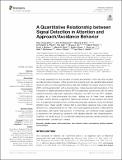A Quantitative Relationship between Signal Detection in Attention and Approach/Avoidance Behavior

View/
Author
Viswanathan, Vijay
Sheppard, John P.
Kim, Byoung W.
Plantz, Christopher L.
Ying, Hao
Lee, Myung J.
Raman, Kalyan
Mulhern, Frank J.
Block, Martin P.
Calder, Bobby
Mortensen, Dale T.
Breiter, Hans C.
Note: Order does not necessarily reflect citation order of authors.
Published Version
https://doi.org/10.3389/fpsyg.2017.00122Metadata
Show full item recordCitation
Viswanathan, V., J. P. Sheppard, B. W. Kim, C. L. Plantz, H. Ying, M. J. Lee, K. Raman, et al. 2017. “A Quantitative Relationship between Signal Detection in Attention and Approach/Avoidance Behavior.” Frontiers in Psychology 8 (1): 122. doi:10.3389/fpsyg.2017.00122. http://dx.doi.org/10.3389/fpsyg.2017.00122.Abstract
This study examines how the domains of reward and attention, which are often studied as independent processes, in fact interact at a systems level. We operationalize divided attention with a continuous performance task and variables from signal detection theory (SDT), and reward/aversion with a keypress task measuring approach/avoidance in the framework of relative preference theory (RPT). Independent experiments with the same subjects showed a significant association between one SDT and two RPT variables, visualized as a three-dimensional structure. Holding one of these three variables constant, further showed a significant relationship between a loss aversion-like metric from the approach/avoidance task, and the response bias observed during the divided attention task. These results indicate that a more liberal response bias under signal detection (i.e., a higher tolerance for noise, resulting in a greater proportion of false alarms) is associated with higher “loss aversion.” Furthermore, our functional model suggests a mechanism for processing constraints with divided attention and reward/aversion. Together, our results argue for a systematic relationship between divided attention and reward/aversion processing in humans.Other Sources
http://www.ncbi.nlm.nih.gov/pmc/articles/PMC5318395/pdf/Terms of Use
This article is made available under the terms and conditions applicable to Other Posted Material, as set forth at http://nrs.harvard.edu/urn-3:HUL.InstRepos:dash.current.terms-of-use#LAACitable link to this page
http://nrs.harvard.edu/urn-3:HUL.InstRepos:32072068
Collections
- HMS Scholarly Articles [17922]
Contact administrator regarding this item (to report mistakes or request changes)


